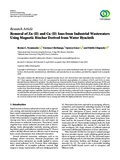Please use this identifier to cite or link to this item:
https://cris.library.msu.ac.zw//handle/11408/3749Full metadata record
| DC Field | Value | Language |
|---|---|---|
| dc.contributor.advisor | ||
| dc.contributor.author | Nyamunda, Benias C. | |
| dc.contributor.author | Chivhanga, Terrence | |
| dc.contributor.author | Guyo, Upenyu | |
| dc.contributor.author | Chigondo, Fidelis | |
| dc.date.accessioned | 2019-12-10T08:00:28Z | |
| dc.date.available | 2019-12-10T08:00:28Z | |
| dc.date.issued | 2019 | |
| dc.identifier.citation | Journal of Engineering Volume 2019 | en_US |
| dc.identifier.issn | 2314-4912 | |
| dc.identifier.uri | http://hdl.handle.net/11408/3749 | |
| dc.identifier.uri | https://doi.org/10.1155/2019/5656983 | |
| dc.description.abstract | This study evaluates the effectiveness of magnetic biochar (Fe2O3-EC) derived from water hyacinth in the removal of Cu+2 and Zn+2 from aqueous solution. Fe2O3-EC was prepared by chemical coprecipitation of a mixture of FeCl2 and FeCl3 on water hyacinth biomass followed by pyrolysis. The adsorbent was characterized by Fourier transform infrared spectroscopy (FTIR) and scanning electron microscopy (SEM) coupled with energy dispersive spectroscopy (EDX). Batch adsorption studies on the effects of temperature, biosorbent dosage, contact time, and initial metal ion concentration were carried out. Fe2O3-EC exhibited optimum contact time, biosorbent dosage, and pH values of 65 min, 1.2 g, and 6, respectively. Fe2O3-EC exhibited strong magnetic separation ability and high sorption capability. Metal ion adsorption onto the biochar conformed to the Langmuir isotherm. Kinetic studies revealed that the adsorption process followed pseudo-second-order model. The calculated thermodynamic parameters showed that the adsorption process was feasible and exothermic in nature. These results have demonstrated that the use of Fe2O3-EC in metal ion removal could provide an alternative way to manage and utilize this highly problematic invasive species. | en_US |
| dc.language.iso | en | en_US |
| dc.publisher | Hindawi | en_US |
| dc.subject | Industrial Wastewaters | en_US |
| dc.subject | Magnetic Biochar | en_US |
| dc.subject | Water Hyacinth | en_US |
| dc.title | Removal of Zn (II) and Cu (II) Ions from Industrial Wastewaters Using Magnetic Biochar Derived from Water Hyacinth | en_US |
| dc.type | Article | en_US |
| item.fulltext | With Fulltext | - |
| item.grantfulltext | open | - |
| item.openairecristype | http://purl.org/coar/resource_type/c_18cf | - |
| item.cerifentitytype | Publications | - |
| item.languageiso639-1 | en | - |
| item.openairetype | Article | - |
| Appears in Collections: | Research Papers | |
Files in This Item:
| File | Description | Size | Format | |
|---|---|---|---|---|
| 5656983.pdf | 2.11 MB | Adobe PDF |  View/Open |
Page view(s)
20
checked on Jul 26, 2024
Download(s)
14
checked on Jul 26, 2024
Google ScholarTM
Check
Items in MSUIR are protected by copyright, with all rights reserved, unless otherwise indicated.



